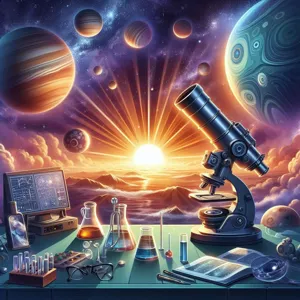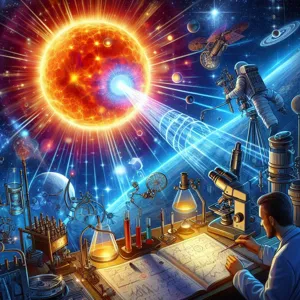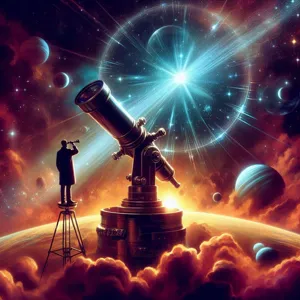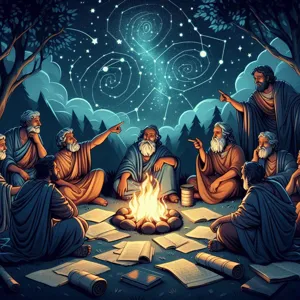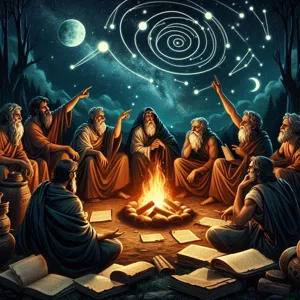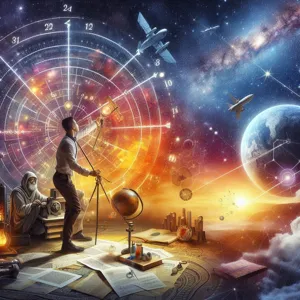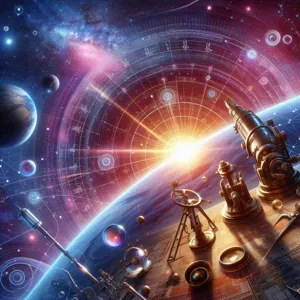Light, the universal language of the cosmos, serves as both a guide and a key to unlocking the mysteries of the universe.
From the shimmering glow of distant stars to the subtle hues of galaxies swirling in the depths of space, light is the vital ingredient that allows astronomers to explore and understand the vastness of our universe. This blog post delves into the crucial role that light plays in astronomy, illuminating not only celestial bodies but also the intricate processes that govern their behavior and evolution. By examining the spectrum of light emitted by stars, the techniques used to capture and analyze this radiant information, and the groundbreaking discoveries that have emerged as a result, we will embark on a journey through the cosmos that highlights the significance of light in our quest for knowledge about the universe. Join us as we explore how this fundamental element shapes our understanding of space, time, and everything in between.
1. Introduction to Astronomy and the Importance of Light

Astronomy, the age-old pursuit of understanding the universe beyond our own planet, opens a window to the cosmos that has fascinated humanity for millennia. From the ancient stargazers who mapped constellations using nothing but the naked eye, to today’s sophisticated observatories equipped with cutting-edge technology, the field of astronomy has evolved dramatically. Yet, one fundamental element remains at the core of this exploration: light.
Light is not merely a tool for astronomers; it is the very essence of their observations. The vast distances that separate us from celestial objects mean that we rely heavily on the light they emit or reflect to gather information about their composition, temperature, motion, and even the very fabric of space and time. Each beam of light carries with it a treasure trove of data, telling stories of the universe’s origins, its ongoing evolution, and its potential future.
In this introduction, we will explore why light is indispensable to astronomy, delving into the mechanisms of light propagation, the spectrum of electromagnetic radiation, and how various wavelengths reveal different cosmic phenomena. From the brilliant glow of nearby stars to the faint whispers of distant galaxies, the light from these entities not only illuminates our night sky but also unlocks the secrets of the universe. Join us on this illuminating journey as we uncover the pivotal role light plays in our quest to understand the cosmos.
2. The Nature of Light: Waves and Particles
To truly appreciate the role of light in astronomy, we must first delve into its dual nature—both as waves and as particles. This fundamental concept in physics, often referred to as wave-particle duality, reveals the complexity of light and its interactions with the cosmos.
As waves, light travels through space in rhythmic patterns, characterized by their wavelength and frequency. These waves can be observed in various forms, from the visible spectrum that enables us to see stars and planets, to the infrared and ultraviolet wavelengths used to study celestial phenomena beyond human perception. Astronomers utilize sophisticated instruments, like telescopes equipped with photometers and spectrometers, to capture these waves. By analyzing the light waves emitted or absorbed by distant objects, scientists can uncover vital information about their composition, temperature, distance, and motion, effectively piecing together the universe’s grand narrative.
Conversely, light also behaves as particles, known as photons. This particle-like nature comes into play when light interacts with matter, such as when it strikes the surface of a distant planet or star. The emission or absorption of photons provides a wealth of data on the energy levels of atoms within those celestial bodies, revealing insights into their chemical makeup and physical characteristics. This phenomenon is particularly crucial in the field of spectroscopy, where the unique “fingerprints” of different elements are identified, allowing astronomers to determine the presence of specific elements in stars and galaxies.
Together, these wave and particle characteristics of light form the cornerstone of modern astronomy. They enable us not only to observe the universe but also to interpret the myriad phenomena occurring within it. Understanding how light behaves helps astronomers unlock the secrets of the cosmos—an endeavor that transforms mere starlight into profound knowledge about the origins and workings of the universe itself.
3. How Light Travels Through Space

Light travels through the vast expanse of space in a manner that is both awe-inspiring and fundamental to our understanding of the universe. Unlike sound waves, which require a medium such as air or water to propagate, light is an electromagnetic wave that can traverse the vacuum of space. This remarkable ability allows light from distant stars and galaxies to reach us, illuminating the cosmos and enabling astronomers to study the universe’s past and present.
When we talk about light traveling through space, we must consider its speed—approximately 299,792 kilometers per second (or about 186,282 miles per second). This incredible speed means that light can travel the distance from the Earth to the Moon in just over a second, and it takes about eight minutes for sunlight to reach our planet. However, when we look at the light from distant celestial objects, we are often peering back in time. For instance, the light from the nearest star system, Alpha Centauri, takes over four years to reach us, meaning we see it as it was four years ago, not as it is today.
As light travels through space, it encounters various cosmic phenomena that can alter its path and properties. Gravitational lensing, for instance, occurs when a massive object, like a galaxy or a black hole, bends the light from objects behind it, allowing astronomers to observe and study these distant formations in ways that would otherwise be impossible. Additionally, light can be absorbed or scattered by interstellar dust and gas, which can obscure our view of certain regions of the universe, presenting challenges to astronomers as they attempt to map the cosmos.
The spectrum of light is also crucial in astronomy. Different wavelengths of light—ranging from radio waves to gamma rays—provide distinct information about celestial objects. For instance, infrared light can reveal cooler objects like dust clouds and newly forming stars, while ultraviolet light can unveil the hot, energetic processes occurring in young stars and galaxies. By studying these various wavelengths, astronomers can piece together a more comprehensive picture of the universe, its structure, and its evolution.
In essence, light is not just a source of illumination; it is a vital tool in the astronomical toolbox, enabling scientists to unravel the mysteries of the cosmos, from the birth of stars and galaxies to the expansive dance of dark matter. Understanding how light travels through space enhances our appreciation for the universe’s splendor and complexity, reminding us that even the faintest glimmer can carry stories spanning billions of years.
4. The Electromagnetic Spectrum: Beyond Visible Light
When we think of light, the first thing that often comes to mind is the visible spectrum—the colors we can see with our naked eyes, ranging from vibrant reds to deep violets. However, the universe is awash with a diverse array of electromagnetic radiation beyond this narrow band, each wavelength offering unique insights into the cosmos. The electromagnetic spectrum encompasses radio waves, microwaves, infrared radiation, ultraviolet light, X-rays, and gamma rays, each playing a pivotal role in our understanding of celestial phenomena.
Radio waves, for instance, are crucial for studying distant galaxies and cosmic background radiation, providing a window into the early universe’s conditions. Astronomers use large radio telescopes to capture these signals, revealing the hidden dynamics of stellar formations and the presence of complex molecules in space. Moving up the spectrum, infrared light allows us to peer through cosmic dust clouds that obscure visible light, revealing the birthplaces of stars and even the faint glow of distant exoplanets.
Ultraviolet radiation, on the other hand, is essential for examining the hotter and younger stars that emit light at these higher energy levels. By analyzing UV spectra, astronomers can glean information about a star’s temperature, mass, and chemical composition, providing clues to the life cycles of celestial bodies. X-rays and gamma rays, the most energetic forms of light, unveil some of the universe’s most violent and energetic events, such as supernovae, black holes, and neutron stars. These high-energy phenomena emit radiation that can only be detected by specialized telescopes placed in orbit, far from the Earth’s atmosphere.
Understanding the electromagnetic spectrum is not merely an academic exercise; it is the key to unlocking the mysteries of the universe. Each segment of the spectrum reveals different aspects of cosmic events, allowing astronomers to build a comprehensive picture of the cosmos. By utilizing these various forms of light, we can piece together the intricate tapestry of our universe, from the birth of stars to the evolution of galaxies, illuminating the vastness of space in ways that visible light alone could never achieve.
5. Telescopes: Harnessing Light to Explore the Universe

Telescopes have revolutionized our understanding of the cosmos, serving as powerful instruments that harness light to unveil the universe’s mysteries. At their core, telescopes collect and magnify light from distant celestial objects, allowing astronomers to observe phenomena that are often billions of light-years away. The ability to capture light—whether visible, infrared, or ultraviolet—enables us to decode the complex stories written in the stars, galaxies, and nebulae.
Reflecting telescopes, which utilize mirrors, and refracting telescopes, which use lenses, are two primary types that have shaped astronomical observation. The Hubble Space Telescope, one of the most iconic examples, orbits Earth, free from atmospheric distortion, capturing breathtaking images and providing invaluable data about the universe’s expansion, the life cycles of stars, and the presence of exoplanets. Its ability to collect light across various wavelengths has opened a window into realms previously thought inaccessible, revealing the intricate structure of cosmic phenomena.
Moreover, ground-based telescopes, equipped with adaptive optics, can correct for the atmospheric disturbances that blur our view of the night sky. These technological advancements allow astronomers to peer deeper into space with unprecedented clarity, leading to groundbreaking discoveries. The quest to harness light for astronomical exploration doesn’t stop there; new developments in spectroscopy allow scientists to analyze the light emitted or absorbed by celestial bodies, revealing their composition, temperature, and even the presence of water vapor—essential clues in the search for extraterrestrial life.
In essence, telescopes are not merely instruments; they are our eyes to the universe. By harnessing light, they bridge the gap between the vast unknown and our insatiable curiosity, illuminating the cosmos and expanding our understanding of our place within it. As technology continues to advance, the role of light in astronomy will only become more pivotal, guiding us toward new frontiers in the exploration of the universe.
6. Spectroscopy: Unlocking Secrets of Celestial Bodies
Spectroscopy is one of the most powerful tools in the astronomer’s toolkit, allowing us to unlock the secrets of celestial bodies light-years away. At its core, spectroscopy involves the study of the interaction between light and matter; it analyzes the light emitted, absorbed, or scattered by objects in space. By dispersing light into its component colors, astronomers can glean invaluable information about the composition, temperature, density, and motion of distant stars and galaxies.
When we observe a star through a spectroscope, we see a spectrum that reveals a unique fingerprint of elements present in that star’s atmosphere. Each element emits and absorbs light at specific wavelengths, leading to distinct patterns known as spectral lines. For instance, the presence of hydrogen can be identified by its characteristic lines in the spectrum, while the signature of helium or heavier elements like iron can tell us about stellar processes and even the star’s age.
But the magic of spectroscopy doesn’t stop at identifying elements. It also provides insights into the physical conditions of celestial bodies. By studying the intensity and width of spectral lines, astronomers can determine the temperature and pressure within stars, or even the speed at which a galaxy is moving toward or away from us—a phenomenon known as redshift and blueshift. This information is crucial for understanding the expansion of the universe and the dynamics of cosmic structures.
Moreover, spectroscopy extends beyond stars to planets, comets, and even distant exoplanets. By analyzing the light reflected off a planet’s atmosphere, scientists can detect gases that might indicate the potential for life, such as oxygen or methane. This not only deepens our understanding of the universe but also brings us one step closer to answering the age-old question: Are we alone in the cosmos?
In essence, spectroscopy serves as a cosmic magnifying glass, revealing the underlying truths of the universe. As technology advances, so too do our capabilities in spectroscopic analysis, illuminating the cosmos like never before and expanding our understanding of the intricate tapestry of the universe.
7. The Role of Light in Understanding Cosmic Distance

Understanding cosmic distance is one of the most profound challenges in astronomy, and light plays a pivotal role in unraveling this mystery. The vast expanses of the universe can often feel unfathomable, but thanks to the behavior of light, astronomers have developed remarkable methods to gauge the distances to celestial objects, from the nearest stars to the most distant galaxies.
One of the fundamental techniques employed is the concept of parallax. By measuring the apparent shift in a star’s position against the background of more distant stars as Earth orbits the Sun, astronomers can calculate distances with astonishing accuracy. This method relies on light’s ability to travel across space, revealing how far away objects are based on their apparent motion. The farther away a star is, the smaller the shift appears, providing a direct correlation between distance and the observable angle change.
In addition to parallax, astronomers use the intrinsic brightness of certain types of stars, known as standard candles, to measure distance. For example, Cepheid variable stars have a well-defined relationship between their luminosity and their pulsation period. By observing the light emitted from these stars and determining their brightness, astronomers can infer how far away they are. This method, known as the distance ladder, connects various distance measuring techniques to create a comprehensive framework for understanding the scale of the universe.
Furthermore, the light from distant galaxies carries information about their redshift, which occurs due to the expansion of the universe. By analyzing the spectrum of light emitted from these galaxies, astronomers can determine how fast they are moving away from us. This redshift data not only reveals distance but also provides insight into the rate of the universe’s expansion, a crucial factor in cosmology.
Ultimately, light acts as the cosmic messenger, bridging the vast distances between us and the stars. Through its myriad interactions and properties, it enables astronomers to map the universe, offering a glimpse into the structure and evolution of cosmic entities. Without light, the universe would remain an incomprehensible void, but through its study, we unlock the secrets of distance, time, and the grand tapestry of the cosmos.
8. Light Pollution: Impact on Astronomy and Solutions
Light pollution is an ever-growing concern in the field of astronomy, casting a veil over the celestial wonders that have inspired humanity for millennia. As urban areas expand and artificial lighting becomes more pervasive, the night sky, once a canvas of stars, is increasingly obscured by a bright, artificial glow. This phenomenon not only diminishes our ability to observe distant galaxies and celestial events but also disrupts the delicate ecosystems on Earth that depend on natural light cycles.
The impact of light pollution on astronomy is profound. Professional and amateur astronomers alike struggle to obtain clear images of celestial bodies when competing with the glare of streetlights, billboards, and illuminated buildings. This interference can lead to inaccurate data collection and hinder our understanding of the universe. Frustratingly, many of the faint objects that astronomers seek—such as nebulae and distant quasars—are rendered invisible to the naked eye, robbing us of the chance to explore the mysteries of the cosmos.
However, there are effective solutions to combat light pollution and restore the night sky. One of the most promising approaches is the implementation of better lighting designs that minimize glare and direct light downward, rather than allowing it to spill into the atmosphere. Shielded fixtures and the use of motion sensors can significantly reduce unnecessary lighting while still ensuring safety and security in urban environments.
Additionally, raising public awareness about the importance of preserving dark skies is crucial. Educational campaigns can inform communities about the impact of light pollution and encourage them to adopt “dark sky” initiatives, such as turning off lights during specific hours or participating in community star-gazing events.
Advocating for local ordinances that promote responsible outdoor lighting can also play a vital role in mitigating light pollution. By engaging with city planners and policymakers, astronomers and citizens alike can work together to create a balance between development and the preservation of our night sky.
Ultimately, addressing light pollution not only enhances our ability to observe the universe but also fosters a deeper appreciation for the wonders of the cosmos. By taking steps to reduce artificial lighting, we can reclaim the brilliance of the stars and inspire future generations to look up in awe, igniting a passion for astronomy that transcends the boundaries of our planet.
9. The Significance of Light in Determining Stellar Composition
Light is the key that unlocks the mysteries of the universe, particularly when it comes to determining the composition of stars. Every star emits a unique spectrum of light, much like a cosmic fingerprint, that reveals vital information about its elemental makeup. By studying this light, astronomers can decipher the chemical elements present within a star, as well as their abundance and physical conditions.
When light travels from a star to Earth, it passes through various layers of gas and dust, which can absorb and scatter specific wavelengths. This process results in the formation of absorption and emission lines in the spectrum of the star. Each element—hydrogen, helium, calcium, and beyond—has a distinct set of lines, allowing astronomers to identify the elements present in a star’s atmosphere. For example, the prominent hydrogen lines in a star’s spectrum indicate that hydrogen is its primary component, while the presence of heavier elements like iron or magnesium can reveal more about its age and evolutionary stage.
This analysis is not merely an academic exercise; it has profound implications for our understanding of the universe. By determining the composition of stars, astronomers can glean insights into stellar formation and evolution, the lifecycle of galaxies, and even the origins of the universe itself. Moreover, it helps scientists trace the pathways through which heavy elements are created in stars and distributed throughout the cosmos, contributing to the formation of planets and, ultimately, life.
In essence, light serves as both a messenger and a tool in astronomy, illuminating the intricate processes that govern the cosmos. As we continue to explore the universe, the significance of light in determining stellar composition will remain a cornerstone of our quest to understand the fundamental building blocks of everything we see around us.
10. Gravitational Lensing: Light’s Role in Unveiling Dark Matter
Gravitational lensing is one of the most fascinating phenomena in the universe, revealing the hidden structures of our cosmos through the manipulation of light. As light travels through space, it encounters massive objects such as galaxies or clusters of galaxies. According to Einstein’s theory of general relativity, these massive bodies warp the fabric of space-time, causing the light from more distant objects to bend around them. This bending effect acts as a cosmic magnifying glass, amplifying and distorting the images of objects behind the lensing mass.
Astronomers have harnessed this effect to study phenomena that would otherwise remain obscured from our view, particularly dark matter. Dark matter, which is believed to make up about 27% of the universe, does not emit or interact with light in a way that we can directly observe. However, its presence becomes evident through the gravitational lensing it causes. By analyzing the distorted light from galaxies located far behind a cluster of galaxies, researchers can map the distribution of dark matter within the lensing cluster. The patterns of light distortion reveal where dark matter is concentrated, shedding light on its elusive nature.
This technique not only helps in identifying the presence of dark matter but also aids in understanding the large-scale structure of the universe. By studying multiple lensing events, astronomers gain insights into the growth of cosmic structures and the dynamics of galaxy formation. Gravitational lensing has thus become an invaluable tool in contemporary cosmology, allowing scientists to explore the unseen and unravel the mysteries of the cosmos. Through the interplay of light and gravity, we are slowly piecing together the intricate puzzle of the universe—one lens at a time.
11. The History of Light in Astronomy: Milestones and Discoveries
The history of light in astronomy is a captivating journey of discovery that has shaped our understanding of the universe. From the early days of stargazing by ancient civilizations to the sophisticated telescopes of modern times, light has been the key to unlocking the mysteries of the cosmos.
One of the earliest milestones occurred in the 4th century BCE when philosophers like Aristotle observed the stars and planets, pondering their nature and movement. However, it wasn’t until the invention of the telescope in the early 17th century by figures like Galileo Galilei that humanity began to see the universe with unprecedented clarity. Galileo’s observations of celestial bodies, such as the moons of Jupiter and the phases of Venus, transformed our understanding of the solar system and challenged long-held beliefs about Earth’s place within it.
The 19th century brought another revolution with the development of spectroscopy, a technique that analyzes the light spectrum emitted or absorbed by objects in space. Pioneers like Joseph von Fraunhofer and William Huggins harnessed this tool to identify the chemical composition of stars, unveiling the fundamental elements that make up the cosmos. Their work laid the groundwork for understanding stellar evolution and the lifecycle of celestial bodies.
As technology progressed, so did our ability to observe light across various wavelengths. The launch of space telescopes, such as the Hubble Space Telescope in 1990, enabled astronomers to capture stunning images of distant galaxies and nebulae. These observations not only deepened our appreciation for the beauty of the universe but also provided critical data for understanding phenomena like dark matter and dark energy.
Today, the study of light in astronomy continues to evolve, with advancements in infrared and radio astronomy pushing the boundaries of our understanding even further. Each milestone in the history of light has illuminated new pathways for exploration, reminding us that the cosmos is vast and full of secrets waiting to be unveiled. As we reflect on these discoveries, we are reminded of the profound connection between light and our quest to comprehend the universe around us.
12. Future Technologies: Advancements in Light-Based Astronomy
As we stand on the precipice of a new era in astronomical exploration, advancements in light-based technologies are set to revolutionize our understanding of the cosmos. The future of astronomy is not just about observing the stars; it’s about harnessing the power of light in innovative ways to unveil the universe’s many mysteries.
One promising avenue lies in the development of adaptive optics, which has significantly enhanced the clarity of ground-based telescopes. By compensating for the distortions caused by Earth’s atmosphere in real-time, these systems allow astronomers to capture images with unprecedented resolution. Looking ahead, further advancements in this technology could lead to even more refined observations, pushing the boundaries of what we can detect in distant galaxies.
Moreover, the advent of photonic technologies is set to play a pivotal role in light-based astronomy. Photonic sensors, which utilize light to detect and analyze celestial phenomena, are becoming increasingly sophisticated. These sensors offer higher sensitivity and faster response times, enabling astronomers to capture fleeting events, such as supernovae or the rapid flickers of gamma-ray bursts, that traditional methods might miss.
The integration of artificial intelligence (AI) with light-based observational techniques is another exciting development. AI algorithms are being trained to analyze vast amounts of data collected from telescopes, identifying patterns and anomalies that human eyes might overlook. This synergy between light and machine learning could lead to groundbreaking discoveries, from new exoplanets in habitable zones to previously unseen cosmic structures.
Space-based observatories like the upcoming James Webb Space Telescope will further expand our horizons. Equipped with advanced light-detecting instruments, these observatories will allow us to peer deeper into the universe and capture the faintest light from distant stars and galaxies. By observing in various wavelengths—from infrared to ultraviolet—we can gain a multi-dimensional understanding of cosmic events and the formation of celestial bodies.
As we embrace these future technologies, the role of light in astronomy will only become more profound. Each advancement not only enhances our observational capabilities but also deepens our appreciation of the universe’s complexity and beauty. The cosmos, once a distant enigma, is becoming ever more illuminated, inviting us to explore and understand the infinite wonders that lie beyond our planet.
13. The Philosophical Implications of Light in the Universe
Light, in its myriad forms, has long been a source of fascination not just for scientists but for philosophers and thinkers throughout history. As we delve into the cosmos, the role of light transcends mere physical phenomena; it invites profound philosophical contemplation about existence, perception, and the nature of reality itself.
At its core, light serves as the primary messenger of the universe, carrying information across vast cosmic distances. When we gaze at the stars, we are not just observing distant suns; we are witnessing the echoes of history itself. The light from a star that has traveled millions of light-years to reach our eyes tells a story of creation, evolution, and even destruction. This temporal connection raises questions about our place in the universe: Are we mere spectators, or do we play an active role in interpreting and understanding the cosmos?
Moreover, light challenges our perceptions of reality. The phenomenon of light bending around massive objects, known as gravitational lensing, compels us to reconsider our understanding of space and time. It blurs the lines between the seen and the unseen, prompting philosophical inquiries into the nature of perception. What does it mean to “see” something? If our reality is shaped by light—its speed, its behavior—then how can we trust our perceptions as an accurate representation of the universe?
In addition, the dual nature of light as both a particle and a wave invites us to ponder the very fabric of existence. Is the universe fundamentally deterministic, or is there an inherent randomness to its workings? As we explore the cosmos, we are continually confronted with these questions, each answer leading to new layers of complexity.
Ultimately, the philosophical implications of light in the universe extend beyond scientific inquiry; they touch on deep existential themes. Light not only illuminates the physical world but also illuminates our understanding of ourselves and the cosmos at large. As we continue to explore the vast reaches of space, we are reminded that light is more than a fundamental force of nature—it is a bridge connecting our minds to the mysteries of existence, urging us to seek, question, and understand the universe in all its splendor.
14. Conclusion: The Endless Quest for Understanding Through Light
In the grand tapestry of the universe, light serves as both a guide and a messenger, illuminating the mysteries of the cosmos that have captivated humanity for millennia. As we conclude our exploration of the crucial role of light in astronomy, it becomes clear that our quest for understanding is far from over; it is, in fact, an endless journey. Each beam of light that reaches us carries within it the history of celestial bodies, the echoes of the Big Bang, and the intricate dance of galaxies. Through advances in technology, from powerful telescopes to sensitive detectors, we have only scratched the surface of what light can reveal.
The wavelengths of light, whether visible, ultraviolet, or infrared, unlock secrets hidden in the vast expanse of space. They allow us to probe the chemical compositions of distant stars, track the evolution of galaxies, and even seek out exoplanets that may harbor life. Yet, as we push the boundaries of our understanding, we encounter new questions that challenge our current paradigms. What lies beyond the observable universe? How do dark matter and dark energy influence the fabric of space-time?
As we continue to harness the power of light, we are reminded of the profound connection it creates between humanity and the cosmos. It invites us to ponder our place in the universe and inspires future generations to gaze at the stars with a sense of wonder and curiosity. The search for knowledge through the lens of light is not just an academic endeavor; it is a fundamental aspect of our shared human experience. With every discovery, we take one step closer to unraveling the intricate mysteries of the cosmos, igniting a passion for exploration that will endure as long as there are stars to observe and questions to ask. The cosmos, in all its brilliance, beckons us onward in our endless quest for understanding through light.
15. Further Reading and Resources for Aspiring Astronomers
For those eager to dive deeper into the fascinating world of astronomy, a wealth of resources awaits, catering to both budding stargazers and seasoned astronomers alike. Whether you’re looking to enhance your understanding of celestial phenomena, sharpen your observational skills, or simply indulge your curiosity, here are some excellent avenues for further exploration.
**Books:** Start your journey with foundational texts such as “Cosmos” by Carl Sagan, which beautifully intertwines science with philosophy, or “Astrophysics for People in a Hurry” by Neil deGrasse Tyson, which offers a concise overview of key concepts in modern astrophysics. For a more technical approach, “An Introduction to Modern Astrophysics” by Andrew J. Tatum is a comprehensive resource that covers a broad spectrum of topics.
**Online Courses:** Platforms like Coursera and edX offer courses from renowned universities, allowing you to learn from experts in the field. Look for offerings such as “Astronomy: Exploring Time and Space” from the University of Arizona, which guides you through the fundamental principles of astronomy and the tools used by professionals.
**Podcasts:** Tune into astronomy podcasts like “StarTalk” hosted by Neil deGrasse Tyson or “Astronomy Cast” with Fraser Cain and Pamela Gay. These engaging discussions provide insights into the latest discoveries, delve into the intricacies of space exploration, and answer listener questions, making complex topics accessible and enjoyable.
**Websites and Online Communities:** Websites such as NASA’s official site, Space.com, and the European Southern Observatory (ESO) provide up-to-date news, articles, and resources that cater to all levels of interest. Additionally, joining online forums like Cloudy Nights or Reddit’s r/Astronomy can connect you with like-minded enthusiasts, where you can share experiences, ask questions, and participate in discussions.
**Local Astronomy Clubs:** Don’t overlook the value of community! Joining a local astronomy club can provide hands-on experience with telescopes, access to star parties, and opportunities to learn from experienced astronomers. These clubs often organize events that foster a love for the cosmos and provide networking opportunities with fellow stargazers.
By utilizing these resources, aspiring astronomers can illuminate their understanding of the universe and cultivate a lifelong passion for the wonders of the cosmos. Remember, the journey into astronomy is as rewarding as the discoveries you will make along the way!
In conclusion, light serves as the vital thread that weaves together our understanding of the cosmos, unlocking the mysteries of the universe and guiding astronomers in their quest for knowledge. From the earliest observations made by ancient stargazers to the sophisticated technologies employed by modern telescopes, the study of light has been instrumental in revealing the structure, composition, and evolution of celestial bodies. As we continue to advance our techniques in capturing and interpreting light from distant galaxies and phenomena, we not only deepen our comprehension of the universe but also ignite our curiosity for what lies beyond. We hope this exploration of the crucial role of light in astronomy inspires you to look up at the night sky with newfound wonder and appreciation, and perhaps even encourages you to delve deeper into the fascinating world of astronomical study. Keep your eyes on the stars, for they hold stories waiting to be illuminated!



